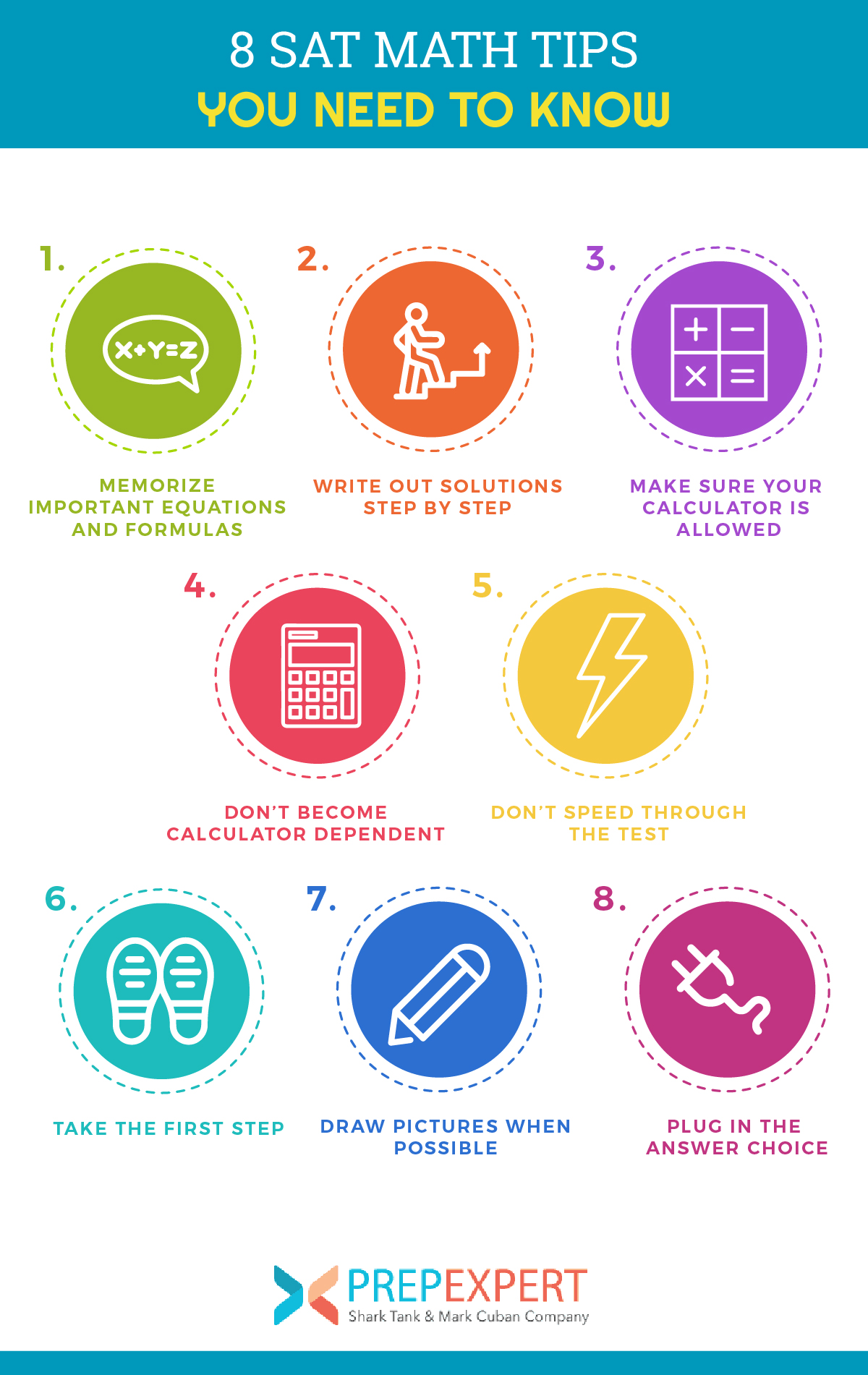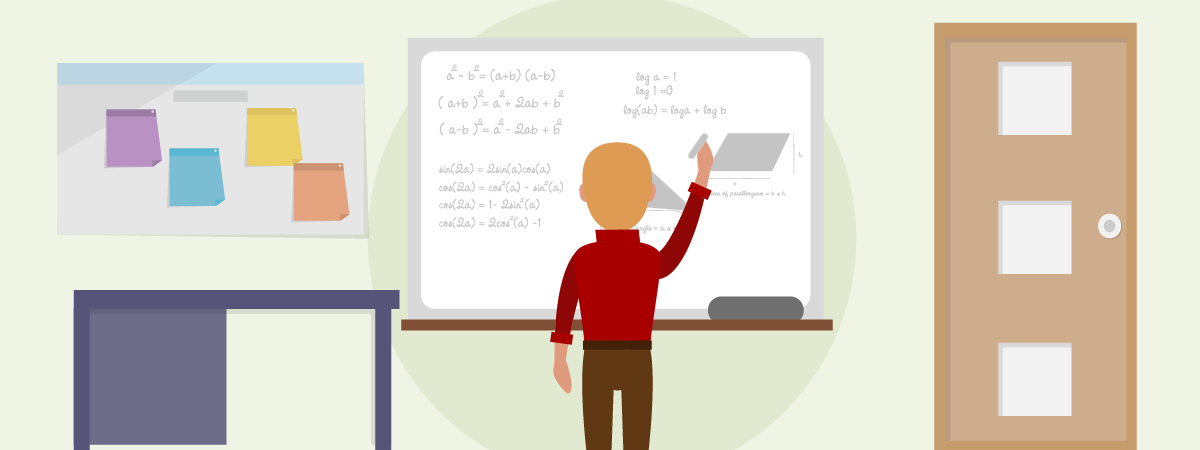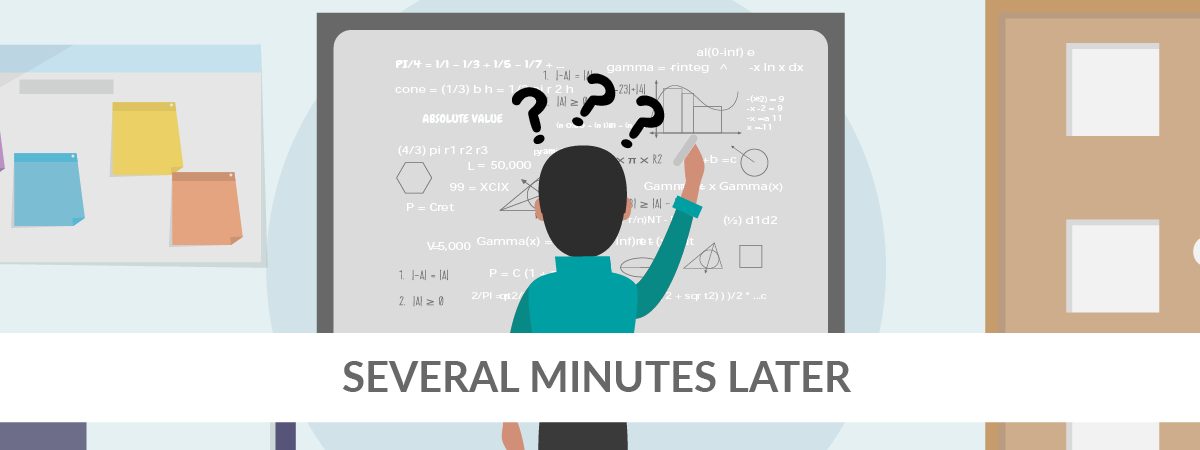8 SAT Math Tips You Need To Know
Many students dread the Math portion of the SAT, either because Math is a tough subject for them, or because they have yet to learn some of the more advanced topics in school.
You can crack the Math tests by memorizing the most important equations and formulas, writing out your solutions step-by-step, knowing when to put your calculator away, drawing pictures, and keeping a deliberate problem-solving pace to avoid making small errors.
And when all else fails, plug the answer choices into the problem! More detailed Math tips below. If you need more help with SAT Math, check out Prep Expert’s SAT prep course.
[sat_one]


Memorize Important Equations And Formulas
You need to know a bunch of equations and formulas to solve many SAT Math problems. Memorize concepts like the Pythagorean theorem, the quadratic equation, and the equation of a line.
To many students’ relief, at the beginning of each Math test, there is a list of equations and formulas necessary for solving the problems featured within. However, don’t take this as an invitation to skip the very important process of memorizing these equations and formulas.
Having instant command of equations and formulas will make you more confident in your problem-solving abilities as you go through the test, leading to a better performance overall. Plus, in the time crunch, going back and forth between the front of the test and the problem you’re solving to check out an equation or formula is a big time waster.
Having these equations and formulas memorized will save you precious seconds, or even minutes, you could use to solve other problems.

Write Out Your Solutions Step By Step
Writing out your solutions step-by-step will help prevent you from making simple mistakes and leaves a record of your work to check.
If you’re a math whiz, you might be tempted to do most of the problem-solving in your head, leaving a relatively clean exam booklet behind. However, it’s in your best interest to write out every problem-solving step, even the relatively simple ones.
One reason why is that many points are lost on the SAT Math tests due to simple mistakes—for instance, factoring incorrectly, or leaving out a decimal place. Writing out every single step reduces this risk.
[sat_two]
Another reason to write out your solutions step by step is that it leaves a record to check back when you’ve finished the test and want to review your work. You can’t check your work if you don’t have any work to check! Go ahead and write it all out—you’ll thank yourself the first time you catch a simple mistake that would have cost you a point off your score.

Make Sure Your Calculator Is Allowed In The Test Center
The SAT doesn’t allow certain types of calculators for use on the test. Make sure yours is approved.
You’ll want to use your calculator on the Math test, so make sure the version you use isn’t prohibited. The College Board includes a list of permitted calculators on its website, so check in advance to make sure yours is on the list.
Most of the Texas Instruments (TI) calculators students use in school are allowed, so if that’s what you have, you should be OK. However, some TI calculators with CAS (Computer Algebra Systems) are not allowed, nor are smartphones, or anything that makes noise.
So, double-check, you don’t want to have to take the test without the aid of your calculator! Furthermore, make sure you know how to use your calculator. It’s not much use to you if you don’t know how to use it to do things like graph lines or factor.
Put in a new battery before the test, and even bring a spare with you, just in case of an emergency. Nothing could be more anxiety-provoking than having your calculator die right in the middle of the test. This has happened to a few of my students!

Don’t Become Dependent On Your Calculator
Knowing how to solve problems without your calculator will improve your confidence level and prevent you from making simple mistakes.
Calculators are a tremendously useful tool on the second Math test, where you’re allowed to use them. However, if you use your calculator to solve problems in lieu of writing out all the steps, at some point you’re likely to hit the wrong button or to leave out a step without noticing.
You’re also likely to panic or become anxious if you reach a problem and realize you don’t know how to solve it without your calculator. This is why knowing how to solve problems step-by-step without a calculator is so important. Your calculator should be used merely as an aid, rather than as a crutch.

Don’t Speed Through The Test
Remember that all the problems on the Math tests are worth the same number of points—don’t rush to finish all of them at the cost of losing points on the easier problems.
As you’ve probably noticed, many of the tips in this post are related to preventing you from making simple mistakes on the Math tests. One common reason this happens is that students often rush to finish all the problems on the tests.
Because the problems get more difficult as you progress, many students think that they have to speed through the tests’ beginning parts in order to finish everything on time. The problem with this practice, though, is that rushing causes you to make simple mistakes.
Even if you rush the easy problems, and then get many of them wrong because of simple mistakes, you’re still likely to lose points on the tougher questions, where the math is more difficult. More importantly, there may be some instances where you might not know how to come up with a solution.
So, go at a deliberate pace. If you get all the easy and medium level questions right and are forced to guess on the last few hard problems, then you’re still likely to get a higher score than you would have had you sped through the entire test. Remember, your goal is getting as many points as possible, not finishing the tests on time at any cost.

Take The First Step
If you’re stuck on a problem, take any step you know how to do and see if that opens the problem up. If not, move on in order to save time.
If you find yourself staring at a problem mindlessly, with no idea how to solve it, try taking any step you can—whether that step is factoring, finding a common denominator, or even doing simple addition or subtraction. Oftentimes, after doing this, you will see the problem in a new light, and the way to a solution will become clear.
If this doesn’t happen, however, circle the question and move on. A good rule of thumb is to spend no more than 10 seconds looking at a problem and doing nothing before moving on.
Spend your time actually solving problems! If you have extra time at the end of the test, you can come back to the trouble problems, and by then perhaps your unconscious will have unlocked them for you.

Draw Pictures When You Can
Rather than taking extra time, drawing figures will save you time by helping you puzzle out problems more quickly and efficiently.
Anytime a word problem describes a shape or a figure, draw it out. Drawing out problems helps to make clear the steps you need to take, and the information you need to find, in order to solve problems.
This point is especially true for things like geometry problems, where you’ll be using tools such as SOH CAH TOA and the Pythagorean theorem. Take note: when a problem does give you a figure or a shape, don’t assume that it’s to scale. You can only assume a figure is to scale when you’re explicitly told so.
[leadmagnet_two]
The exception to this rule is when you’re guessing. If so, go ahead and assume the figure is to scale. Generally, it’s better to guess using possibly incorrect information than it is to guess using no information at all.

When All Else Fails, Plug-In The Answer Choices
If you’re unsure how to solve a problem, plug each answer choice back into the problem and see if one of them works.
In many instances, one of the answer choices will work as a solution to the problem, and if so, that answer choice is correct. However, you should only take this step when you don’t know how to solve the problem on your own.
Why? Because plugging in is a time-consuming process (you have to check all the answer choices to be sure you haven’t made a mistake). Also, this trick won’t always work.
[sat_three]
For more test strategy, college admissions, and scholarship application tips sign up for our FREE class happening right now!